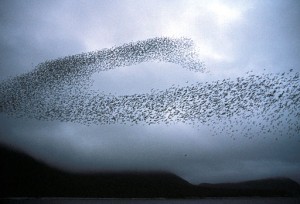This is the third in a 5 week series exploring the relationship between miracles and science. See this Science Corner post for a prelude, this post for part 1 and this post for part 2.

Two weeks ago, we started our exploration of miracles by looking at how human monarchs influence our perception of God as king. Last week, we considered the possibility that the metaphor of laws may not be the best fit for describing how the universe works. I proposed the idea of will as the basis for an alternative description. I suspect that leads naturally to wondering if everything is running around doing whatever it wants, where does that leave God’s sovereignty? Wouldn’t we be left with a world in chaos?
To answer that question, we’re going to need a little math, since that’s how the traditional laws of nature are typically expressed. These expressions, or equations, take what you know about the current state of whatever system you are interested in and tell you how that system will change over time. For example, let’s say you have a ball you want to throw to your friend. You can completely determine the flight path of the ball by choosing how hard (how fast) you throw it and at what angle. The equations known as the laws of motion will tell you the exact shape of path the ball will then follow.
Knowing the path your ball will follow is pretty handy; in essence, it allows you to know the future. Clairvoyance is handy enough, and yet these equations have another nice property. Let’s say your first choice of angle and speed predict a path that falls short of your target. No problem, just adjust the speed a little bit and your ball will fly just a little farther. Or tweak the angle a little lower and you’ll get a comparable small change in the result. That makes it pretty easy to figure out what conditions you need at the start to get the result you want in the end. In fact, these adjustments likely come so naturally you might never have even noticed that’s how throwing works, or never imagined that the world could be otherwise. Our brains are conditioned to expect this behavior.
But for the sake of argument, let’s try to picture a world that does work differently. You throw a ball to your friend and it lands a little short. On the next throw, you add a little more oomph; this time, the ball plops down right at your feet. Puzzled, you try again a little harder and now it sails over your friend’s head. Trying one final time, you take a little something off only to see the ball sail even further and land three houses away. If that’s the world you lived in, you’d probably swear off the game of catch from that point forward.
No one would want to live in a world that behaved that way, and so no one would look for math to describe such a world. When some equations were found to work that way anyway, the new branch of mathematics was dubbed chaos theory, presumably to warn future mathematicians that here be dragons. Undaunted, some folks studied it anyway and discovered another surprising property. Although individual steps are difficult to predict because the smallest changes can lead to big differences in results, in the long run there are still patterns to be found. And because these patterns are borne of chaos, they have a certain robustness. You can start the system with a variety of different conditions and ultimately it will wind up in the same pattern.

The math of chaos theory is interesting, but does it bear any resemblance to the real world? Astonishingly, yes. While the famous butterfly effect — a butterfly flapping its wings in one part of the world causing a hurricane in another — is more of an illustration than a reality, chaos theory is relevant to the weather, as well as related phenomena like turbulence. It has been observed in population dynamics and heart disease, in vehicle traffic, and even the furthest reaches of space. The robustness of chaotic organization can be seen in pendulum systems and the behavior of neurons in the brain. Whether we like it or not, we appear to live in a world of chaos.
Here’s where the name of chaos theory becomes somewhat unfortunate, because I think it’s actually a good thing our world exhibits chaotic dynamics. The property I described as robustness could also be described as grace. It is the quality of allowing for deviations, for errors, without derailing the entire system. The math of more traditional laws does not exhibit grace; if a system shifts from the expected path, it won’t automatically shift back.
This property of grace also means that freedom can coexist within the context of some form of plan, or of sovereignty if you prefer. At any moment, there is a freedom to choose, and yet certain long term, big picture outcomes will still come to fruition. Now, does that mean our lives are still fated, while offering only the illusion of freedom? I don’t think so. It is entirely possible, for example, that none of the outcomes of our individual lives are constrained by such a plan, that it operates at a higher level of organization such as the church. That doesn’t necessarily mean God has no designs for our individual lives, just that he can plausibly allow us the freedom to decide whether to implement those designs without abdicating all claims to sovereignty.
Now, to be clear, I won’t pretend to know exactly the form that God’s will assumes. I wouldn’t even assert that it could definitely be described mathematically. I just think that if a mathematical system can exhibit freedom, robustness, and order, and if that math corresponds to the world as we observe it, then it is reasonable to think that free will, grace, and sovereignty can all be simultaneous features of that world. And that in turn allows us to imagine our world operating according to principles of will rather than being governed entirely by laws.
I find this sort of theoretical foundation to be very helpful; I hope you’ve found it worthwhile also. Next week, we’ll get more concrete by looking at how all of these qualities manifest in the Easter story.
Andy has worn many hats in his life. He knows this is a dreadfully clichéd notion, but since it is also literally true he uses it anyway. Among his current metaphorical hats: husband of one wife, father of two teenagers, reader of science fiction and science fact, enthusiast of contemporary symphonic music, and chief science officer. Previous metaphorical hats include: comp bio postdoc, molecular biology grad student, InterVarsity chapter president (that one came with a literal hat), music store clerk, house painter, and mosquito trapper. Among his more unique literal hats: British bobby, captain’s hats (of varying levels of authenticity) of several specific vessels, a deerstalker from 221B Baker St, and a railroad engineer’s cap. His monthly Science in Review is drawn from his weekly Science Corner posts — Wednesdays, 8am (Eastern) on the Emerging Scholars Network Blog. His book Faith across the Multiverse is available from Hendrickson.

Leave a Reply